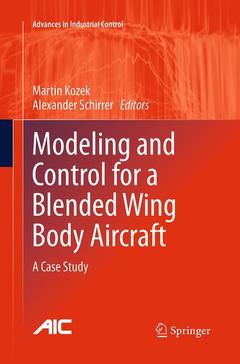Description
Modeling and Control for a Blended Wing Body Aircraft, 2015
A Case Study
Advances in Industrial Control Series
Coordinators: Kozek Martin, Schirrer Alexander
Language: English
Subjects for Modeling and Control for a Blended Wing Body Aircraft:
Publication date: 09-2016
Support: Print on demand
Publication date: 11-2014
301 p. · 15.5x23.5 cm · Hardback
Description
/li>Contents
/li>Comment
/li>
This book demonstrates the potential of the blended wing body (BWB) concept for significant improvement in both fuel efficiency and noise reduction and addresses the considerable challenges raised for control engineers because of characteristics like open-loop instability, large flexible structure, and slow control surfaces. This text describes state-of-the-art and novel modeling and control design approaches for the BWB aircraft under consideration. The expert contributors demonstrate how exceptional robust control performance can be achieved despite such stringent design constraints as guaranteed handling qualities, reduced vibration, and the minimization of the aircraft?s structural loads during maneuvers and caused by turbulence. As a result, this innovative approach allows the building of even lighter aircraft structures, and thus results in considerable efficiency improvements per passenger kilometer. The treatment of this large, complex, parameter-dependent industrial control problem highlights relevant design issues and provides a relevant case study for modeling and control engineers in many adjacent disciplines and applications.
Modeling and Control for a Blended Wing Body Aircraft presents research results in numeric modeling and control design for a large, flexible, civil BWB aircraft in the pre-design stage as developed within the EU FP7 research project ACFA 2020. It is a useful resource for aerospace and control engineers as it shows the complete BWB aircraft modeling and control design process, carried out with the most recent tools and techniques available.
presents research results in numeric modeling and control design for a large, flexible, civil BWB aircraft in the pre-design stage as developed within the EU FP7 research project ACFA 2020. It is a useful resource for aerospace and control engineers as it shows the complete BWB aircraft modeling and control design process, carried out with the most recent tools and techniques available.Advances in Industrial Controlaims to report and encourage the transfer of technology in control engineering. The rapid development of control technology has an impact on all areas of the control discipline. The series offers an opportunity for researchers to present an extended exposition of new work in all aspects of industrial control.
Overview and Motivation.- Conceptual Design.- Numerical Simulation Model.- Reduced-order Modeling.- Control Goals.- Feedback Control Designs.- Feed-Forward Control Designs.- Validation, Discussion and Outlook.
Comparison of numerous control concepts for the same application provides a broad overview and helps control engineers to choose appropriate design concepts for their control problems
The extensive treatment of a large, complex, parameter-dependent industrial control problem provides a useful case study and highlights relevant design issues valid for engineers in many modeling and control disciplines and applications
The presentation of the complete BWB aircraft modeling and control design process with the most recent tools and techniques provides a comprehensive state-of-the-art overview of the range of involved tasks to extend the aerospace and control engineers' experience
Includes supplementary material: sn.pub/extras




